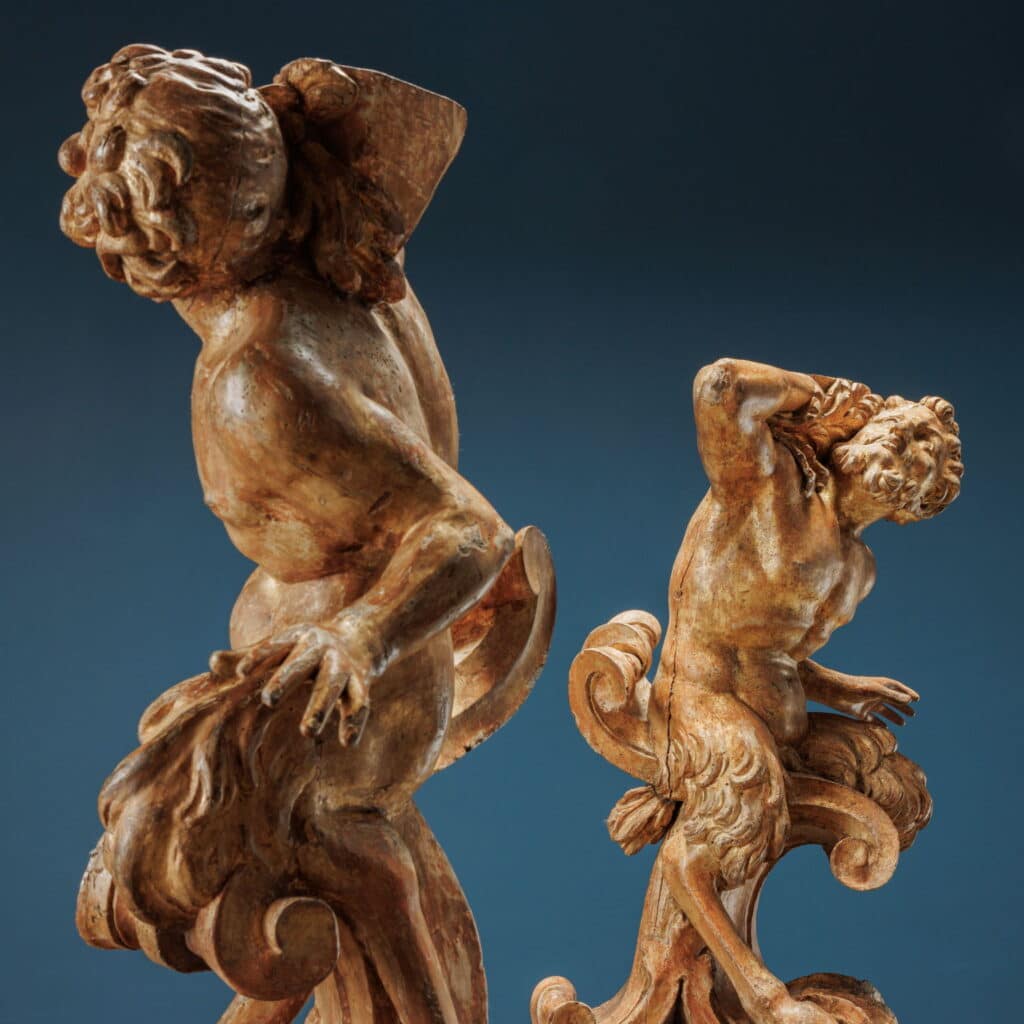Pair of Satyrs, Rome, early 18th century
Rome, early 18th century
Description:
Two architectural spirals, made up of overlapping curls, act as seats for two satyrs bent and stretched in an effort to support a plane beyond which they look, through the twist of the neck that accentuates the dynamism of the effort. To soften the weight between the arm and the shoulder there is a clump of
leaves. They are born in carved linden wood and entirely gilded on the entire surface.
Dimensions: 90 x 53 x 48 cm
CODE: ANTACO0059075
Historical-critical analysis:
These two sculptures depicting satyrs are most likely born as part of a sculptural apparatus or furniture. They show no signs of cuts or reduction while they are designed to act as a support on the head and on the right forearm folded over the shoulder. Furthermore, they are two symmetrical and not opposed figures. The analysis of these aspects leads us to hypothesize that they were supporting elements of a pair of consoles supported by two or four opposing satyrs, then separated into different elements.
The type of sculpture is part of the more mature Baroque style that is expressed in the wake of the ideas of Gian Lorenzo Bernini towards the end of the seventeenth century and the beginning of the eighteenth century. We move from the furnishings of the first period, where the composition is dominated by plant and architectural elements, to the creation of large apparatuses where the mythological or human figure, with characters of great dynamism, becomes very present. Sculptures used not only for tables and furnishings, but also for ecclesiastical apparatuses such as choirs or altars and even in representative carriages.
From those years are the drawings of the carver Filippo Passarini, published in the New inventions of ornaments …, (Rome, 1698), depicting some proposals for consoles and mirrors (fig. 1). A few years later, in 1714, in the diverse Drawings repertoire…. by the silversmith Giovanni Giardini we still find ideas of tables where figure sculpture dominates as a support. In one of these inventions, two satyrs resting on volutes hold up the marble top (fig. 2). The construction of the large tables in the Galleria di Palazzo Colonna in Rome, considered the greatest example of this Baroque production, is also dated between the two centuries. These are undoubtedly the years of making these two sculptures.
When we talk about the Roman Baroque we cannot forget that in reality the whole peninsula is influenced by this language. This stylistic influence can be observed both in the examples of Giacomo Amato and Antonio Grano in Palermo and in the sculptures of Andrea Brustolon in Venice, where Bernini’s lesson is transferred with local influences. Much closer to the original production are the cities of the Papal State but also Florence and above all Genoa thanks to the presence of Filippo Parodi. He spent the years of his training in Bernini’s workshops and brought what he had learned by influencing Ligurian taste to his hometown. In the analysis of these satyrs we delayed on the choice of origin precisely in comparison with some Ligurian creations.
Essential elements in indicating the Roman authorship of these works are on the one hand the presence of those large, typically Roman architectural support motifs, very free and with a clean line, on the other hand the choice of the subject, the faun. As evidenced by the aforementioned drawings, the faun is very present in the Roman repertoire and less in Genoa, where the mythological figure of reference is the triton, due to the evident references to the sea. One of the most beautiful elements of these sculptures, the dynamism of the torsion, which we find for example both in the figures of the tables in the Colonna gallery and in the torch-holding tritons of the Palazzo del Principe in Genoa, attributed to Filippo Parodi, does not help in the choice.
Bibliography:
Alvar Gonzalez-Palacios, The temple of taste, Rome and the Kingdom of the Two Sicilies, ed. Longanesi 1984;
Alvar Gonzalez-Palacios, Furniture in Liguria, ed. Sagep, Genoa 1996.
- Pair of Satyrs, Rome, early 18th century

Antiques, Art and Design
FineArt is the new ambitious Di Mano in Mano project that offers an exclusive choice of antiques and design works, presenting them for their singularity and uniqueness.












